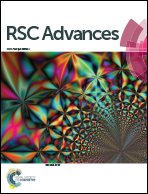Ethylene glycol mediated synthesis of Ag8SnS6 nanoparticles and their exploitation in the degradation of eosin yellow and brilliant green
Abstract
Ag8SnS6 (silver tin sulfide) nanoparticles (17–18 nm) were synthesized using a chemical coprecipitation method using ethylene glycol as a solvent and capping agent and thiourea as a sulfur source at a temperature of 160 °C, 6 h. The as synthesized nanoparticles were characterized by X-ray diffraction (XRD), and transmission electron microscopy (TEM). The optical properties were investigated by using UV-visible NIR spectroscopy. The XRD pattern shows the formation of single phase Ag8SnS6 with a rhombohedral structure. Ethylene glycol mediated synthesis resulted in the formation of spherical Ag8SnS6 nanoparticles as seen from TEM images. Diffuse reflectance spectra show that Ag8SnS6 possesses an absorption profile across the whole visible-light and near-infrared region. Ag8SnS6 exhibits a band gap energy 1.12 eV. Ag8SnS6 shows powerful visible light photodegradation activity towards the degradation of eosin yellow and brilliant green dyes. The enhanced photocatalytic activity of Ag8SnS6 particles is attributed to its improved visible light absorption and efficient separation of photogenerated charge carriers. Studies with different quenchers suggest that superoxide radicals play a major role in the photodegradation process.


 Please wait while we load your content...
Please wait while we load your content...